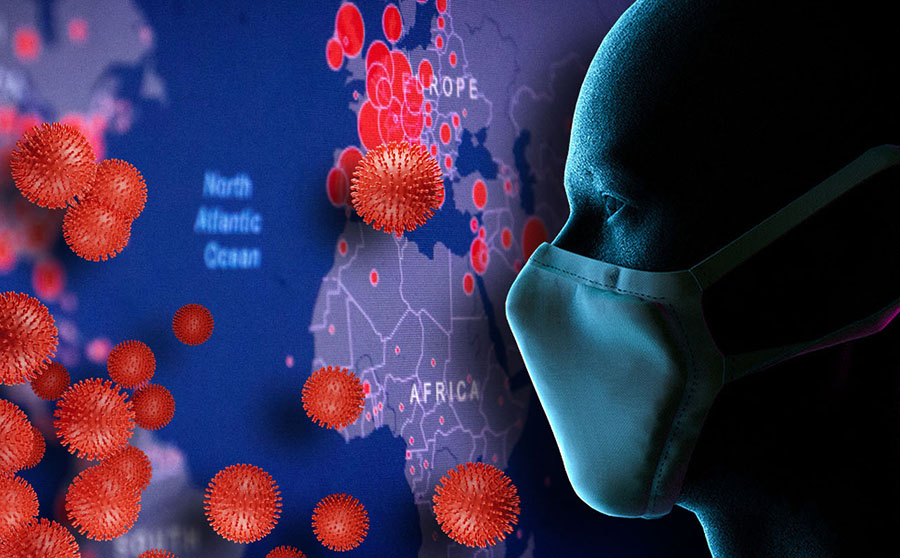Sat 11 July 2020:
We answer some questions about the transmission of COVID-19 through the air, the risks and ways to protect yourself.
More than seven months after the new coronavirus was first detected, scientists and health experts are still trying to get a better understanding of how it spreads and how to curb the COVID-19 respiratory disease it causes.
The coronavirus is transmitted from person to person through “droplet transmission”, including direct contact with someone who has been infected, indirect contact with contaminated surfaces, droplets of saliva from coughing or discharge from the nose when sneezing, according to the World Health Organization (WHO).
Airborne transmission is also possible, but its effects and risks have recently sparked a scientific debate.
What is airborne transmission?
The WHO has long said the new coronavirus spreads mainly through small droplets released from the mouth and nose that fall from the air in a short period.
But some scientists and researchers are increasingly pointing out to evidence that the virus can also be transmitted by even smaller droplets called aerosols. Usually generated when people are shouting and singing, these remain suspended in the air for longer and can travel farther.
How is it different from droplet transmission?
The respiratory droplets sneezed or coughed out are larger in size – a diameter of five to 10 micrometres – and the range of exposure is one to two metres (three to six feet).
Aerosols, however, are less than five micrometres in diameter and travel beyond two metres from the infected individual.
“The new coronavirus can survive in both droplets and aerosol for up to three hours under experimental conditions, although this depends on temperature and humidity, ultraviolet light and even the presence of other types of particles in the air,” Stephanie Dancer, a consultant medical microbiologist in the UK, told Al Jazeera.
“Microscopic aerosols can project at least six metres in indoor environments, and possibly even further if dynamic air currents are operating. The distance depends upon how large the aerosol is.”
How is COVID-19 spreading through the air?
As in droplet transmission, aerosols can be released in several ways including, breathing, talking, laughing, sneezing, coughing, singing and shouting.
“Breathing would not offer much projectile force, but shouting, singing, coughing and sneezing project aerosol through the air with a range of different velocities,” said Dancer.
“Even if one individual particle does not contain enough virus to cause infection, if you carry on breathing in these particles over time, you will acquire enough in your mouth, nose and respiratory tract to initiate infection.”
Airborne transmission can also occur in certain medical procedures that involve the patient generating aerosols, putting healthcare workers particularly at risk.
“Coronavirus can be spread by aerosol under special circumstances if using nebulisers, bronchoscopy, intubation, dental and other oral procedures using suction and lavage,” said Naheed Usmani, president of the Association of Physicians of Pakistani Descent of North America (APPNA).
“This is particularly dangerous for healthcare workers who should only attempt these procedures wearing proper personal protective equipment (PPE), including N95 masks,” she told Al Jazeera.
Is airborne COVID-19 less contagious?
The extent to which the coronavirus can be spread by the aerosol route – as opposed to by larger droplets – remains disputed.
While the WHO has long maintained that the primary source of infection is through droplet transmission, it has acknowledged there was “emerging evidence” of airborne transmission.
This came after a group of 239 scientists from 32 countries and a variety of fields made the case in an open letter that there was a “real risk” of airborne transmission, especially in indoor, enclosed and crowded environments without proper ventilation.
Dancer, who was one of the signatories of the letter, said there is a lower risk of catching the virus the further you are from the source.
Jose-Luis Jimenez, a chemist at the University of Colorado, also told Al Jazeera the “virus loses infectivity over a period of an hour or so indoors”.
How can you protect yourself?
Wearing face masks properly and maintaining physical distancing are recommended at all times.
Experts also recommend avoiding crowded places, especially public transport and public buildings.
In closed spaces at schools, offices and hospitals, increasing proper ventilation with outdoor air by opening windows can also mitigate the risk of infection, Jimenez said.
“For spaces where ventilation cannot be increased, we recommend portable high-efficiency particulate air (HEPA) filter air cleaners or possibly ultraviolet (UV) germicidal lights at the high end of need. We do not recommend other types of air cleaners.”
Follow Saba Aziz on Twitter: @saba_aziz
SOURCE: AL JAZEERA NEWS
Think your friends would be interested? Share this story!





